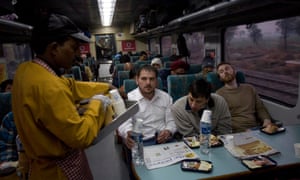On the Golden Temple Mail and the Deccan Queen, the Howrah Express and the Agra Shatabdi, there is one carriage in the long, overcrowded trains rattling across India’s deserts, forests, farmlands and hills which has always been a haven of well-being: the pantry car.
Here, teams of men have toiled over decades to provide trillions of meals to billions of passengers. In a select few trains, multi-course meals have been served. In more modest ones, it has been a basic rice, vegetables and chapatis.
But now the famous pantry car is to be phased out. In a few years, Indian railway officials hope, it will have been largely replaced by “e-catering” and takeaways, which will attempt to satisfy booming India’s increasingly varied gastronomic tastes.
“It’s because people want different types of food. This way we can offer pizza, burgers or continental [European] food. It’s an alternative arrangement,” said Neeraj Sharma, a spokesman for Northern Railway, the state body that runs trains over a huge tract of north India.
But, even if railway fare is known for poor hygiene and grease in quantities more usually found in a train’s engine than its kitchen, there is much resistance to the demise of a treasured tradition.
The dining car, introduced by the British almost a century ago, has long been a rarity. Only one remains in service beyond luxury tourist trains charging 26,000 rupees (£260) a night. The car, on the line linking the southern cities of Pune and Mumbai, has such loyal clients that when it was withdrawn last year a rebellion forced its return.
“It is a wonderful thing. You sit there and enjoy the natural scenes through the window and your breakfast at the same time,” said Vivek Khare, a historian of Indian trains who travels regularly by rail.
Many Indian train journeys are extremely long and very slow. A 600-mile trip, not an unusual distance in the vast country, can take more than 24 hours. Though many people will bring their own food, some kind of fresh sustenance is essential. Snacks can be bought from vendors at stations with specialist guides published advising which local specialities to eat at which stop, but for more filling fare the pantry car has long filled the gap.
Overall more than half a million meals a day are prepared in pantry cars or specialised kitchens and served to passengers. Though prices vary, they are usually extremely low.
“It is part of the Indian way of life,” said Khare. “It is very important to the Indian to eat well. They don’t mind if the train is late but they must get their breakfast.”
The menus of the pantry cars, and the occasional dining cars, have been unchanged for decades. Many still bear the influence of British rule, which ended in 1947, offering breakfasts of limp omelettes, fried “cutlets” of unidentifiable ingredients and baked beans, washed down with strong, sweet tea, irrespective of temperatures soaring to beyond 45C inside and outside the train.
Recent plans to modernise India’s sprawling and underfunded railway network include the introduction of high speed trains and automatically closing doors. Phasing out pantry cars is part of a broader push to develop a “modern system”, officials said.
“This is a long-time plan of the Indian Railways. The idea is to … reduce dependency on private caterers who are in charge of pantry cars. The other reason is to replace the pantry cars with passenger coaches to earn more revenue,” an official told the Times of India newspaper.
Under the new system passengers can preorder their meal on an app or website, by phone or SMS, and then pay online or on delivery at a station of their choice, the newspaper explained.
SK Dutta of the Indian Railway Catering and Tourism Corporation insisted that despite tie-ups with international fast food firms, an Indian gastronomic option would always remain.
“You can surely still order old railway food if you like. Every option will be there. This is the great variety of India, you can describe it like that,” Dutta said.





No comments:
Post a Comment